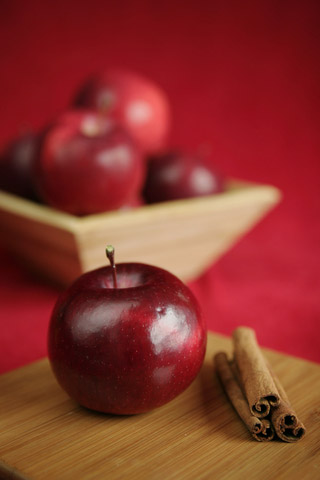5 Favorite New England Apples & Recipes
Amy Traverso, Yankee lifestyle editor and author of The Apple Lover’s Cookbook picks her five favorite native New England apple varieties. Baldwin Apple Category: Firm-sweet Best use: I like to combine Baldwins with firm-tart apples in old-fashioned desserts like pies, crisps, and pandowdies. Origin: Discovered in 1740 on the farm of John Ball in Wilmington, […]

 Amy Traverso, Yankee lifestyle editor and author of The Apple Lover’s Cookbook picks her five favorite native New England apple varieties.
Amy Traverso, Yankee lifestyle editor and author of The Apple Lover’s Cookbook picks her five favorite native New England apple varieties.
Baldwin Apple
Category: Firm-sweet Best use: I like to combine Baldwins with firm-tart apples in old-fashioned desserts like pies, crisps, and pandowdies. Origin: Discovered in 1740 on the farm of John Ball in Wilmington, Massachusetts. It was originally called a Woodpecker because of the birds who frequented the tree, but was renamed after Colonel Loammi Baldwin, who took an interest in the apple and propagated it around the Northeast. Availability: While it lost its dominant place to the Jonathan and the McIntosh in the early 20th century, it’s still available at many pick-your-own farms. Season: Generally ripens in late September through October; keeps until February. Appearance: Medium-large; yellow-orange skin with red stripes. Apples that grow in full sun turn more uniformly red. Taste: More tart than others in this category, but the sweetness dominates. It’s quite aromatic, with flavors of spice and ripe apricots. Texture: Juicy and tender when eaten fresh, but able to hold its shape when cooked.Black Oxford Apple
Category: Firm-sweet Best use: The Black Oxford makes a gorgeous pink applesauce when cooked with its skin on, but it also performs well in crisps and other baked desserts. As an eating apple, it’s best in the winter-like other long-storing fruit, it gets sweeter with time. Origin: This seedling first appeared on the Valentine farm in Paris, Maine, around 1790. In nearby Hallowell, a 200-hundred-year-old Black Oxford tree is still bearing crops today. Availability: This cold-tolerant apple is most popular in its native Maine, but is also grown in Vermont, New Hampshire, and as far south as Virginia. Season: Harvested in late October and early November; keeps well through late spring. Appearance: This stunner is such a deep and rich purple color that it looks more like a plum than an apple. It’s round in shape and usually medium in size. Taste: There’s a pure apple flavor here that’s subtler than you’ll find in modern fruit bombs like the Honeycrisp. Fresh off the tree, it tends to be semi-tart. Texture: Hard, dense, and moderately juicy.Blue Pearmain Apple
Category: Firm-sweet Best use: Cider is its first use, eating fresh is second, but the Blue Pearmain also holds up pretty well when baked whole. Origin: Its origins are uncertain, but it’s a New England native, probably from the late 18th or early 19th century. Availability: Look for it at farmer’s markets and pick-your-own orchards. Season: Ripens in October and November; doesn’t keep much past January. Appearance: A dusty blue natural bloom gives this apple its name. Medium to large in size and quite heavy, with deep red skin accented with purple. Taste: Sweet, mild, and very aromatic, with pear, vanilla, and melon notes. Texture: Skin is tough and waxy; flesh is dense and crisp, if somewhat dry.Rhode Island Greening Apple
Category: Firm-tart Best use: Rhode Island Greening makes a great pie. You can cook it to your heart’s content and know it will hold its shape. It also makes a tasty sauce. Origin: It’s believed to have first grown from seed in the mid-17th century, probably near Newport, Rhode Island, where one Mr. Green owned a tavern near Green’s End. Availability: One of the tart green apples supplanted by the Granny Smith, this beauty was widely available on the East Coast through the 1960s. Today, your best bet is a pick-your-own orchard or farmer’s market. Season: Mid-October is peak harvest time, but stores well into the winter. Appearance: Large, nicely round, and sometimes russeted, with green to yellow-green skin. Taste: Tartness and vegetal notes are the primary flavors here, with a hint of green grape and lemon. Texture: Flesh is dense and solid, but pleasingly juicy once you bite in.Roxbury Russet Apple
Category: Firm-tart Best use: This is really a baking apple more than a snacking one. Like the Rhode Island Greening, this New England native is terrific in pies, tarts, and other rich pastries. Origin: One of America’s oldest apples, this variety grew from seed in Roxbury, Massachusetts, in the early 1600s. Availability: The Roxbury likes a good chill, so it sticks to northern climes. Its humble looks have mostly limited its popularity to New England. Season: Trees generally ripen in mid-October, but the fruit can keep well into the winter. Appearance: This medium-size apple is heavily russeted, with thick skin and yellow-green flesh. Taste: Quite tart, but with a rich sweetness, like lemonade made with honey. Texture: Crisp, dense, and rather coarse, this fruit can still retain some snap after a month or two of storage.Amy Traverso
Amy Traverso is the senior food editor at Yankee magazine and co-host of the public television series Weekends with Yankee, a coproduction with WGBH. Previously, she was food editor at Boston magazine and an associate food editor at Sunset magazine. Her work has also been published in The Boston Globe, Saveur, and Travel & Leisure, and she has appeared on Hallmark Home & Family, The Martha Stewart Show, Throwdown with Bobby Flay, and Gordon Ramsay’s Kitchen Nightmares. Amy is the author of The Apple Lover’s Cookbook, which was a finalist for the Julia Child Award for best first-time author and won an IACP Cookbook Award in the “American” category.
More by Amy Traverso

